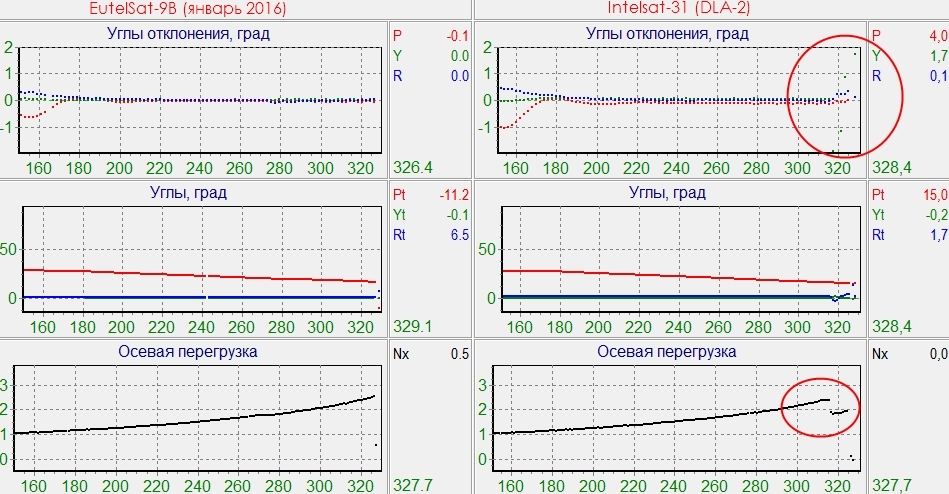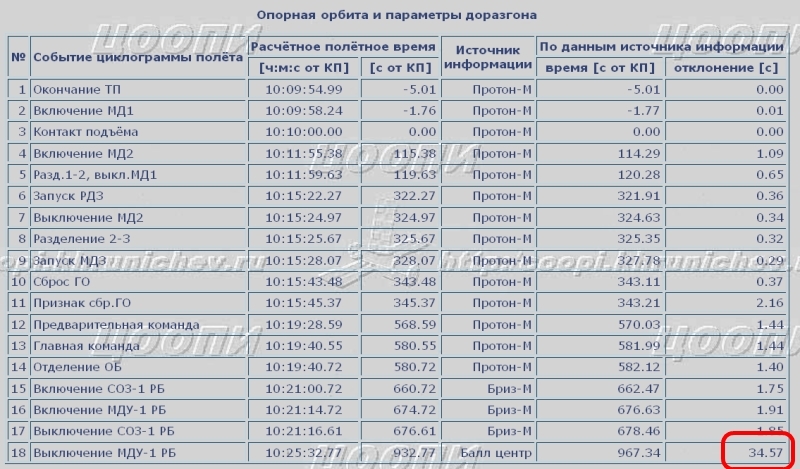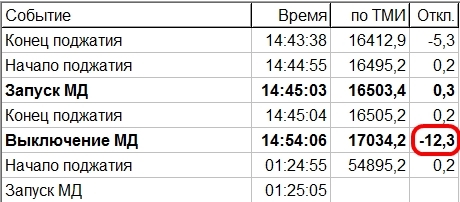Detective with "Proton" or how computers save rockets

A successful space launch attracts little attention. But if you know that the mission to eliminate Intelsat 31 was close to death, it becomes much more interesting. According to the data in open access, it is possible to calculate what happened and why the satellite was nevertheless successfully brought to the desired orbit.
Chronology of drama
The first vague sensation of anxiety appeared when the announcer, who was reporting on the launch with an interval of ten seconds, stopped for as many as forty (from 1:56:00):
The fact that the announcer was silent for a reason, it became clear when telemetry from the work area of the second stage appeared in the public domain:

')
In the region of 315 seconds, the engines thrust fell. Let's try to determine what happened. At the second stage there are four engines (3 RD-0210 and RD-0211). They are almost identical in design, except that the RD-0211 has an additional heat exchanger for pressurized tanks. The total thrust of the four engines is 2400 kilonewtons. We neglected the force of air resistance, because the separation of the second and third stages occurs at an altitude of about 80 km, where there is practically no atmosphere.
There was a mistake in physics and calculations
An overload of 1.8-2 g, compared with a normal 2.5 g in this area, means that the thrust has dropped by about a quarter.
Conclusion : One engine lost traction and was disconnected. Also, this version is confirmed by the increase in deviation angles - the engine, located diagonally from the failed, began to deploy the rocket:

Fortunately, on the second stage, all four engines are in gimbal gimbal, and the control system began to fight for the life of the rocket, compensating for the turning moment by turning the engines. This was not entirely possible, the deviation angles grew, but, fortunately, less than ten seconds remained before the separation, and the second stage did not have time to step aside to stop the flight in an emergency.
But it was too early to relax. The carrier rocket “Proton-M” due to the accident at the second stage didn’t give away the bundle of the Briz-M upper stage and the satellite 28.2 m / s.

It is known that the three stages of the “Proton-M” lead the upper stage and the payload to an open path. If Briz-M does not cope with the lack of speed, then the upper stage and the expensive satellite will be in the Pacific Ocean. The Brize had a hard time — a relatively low-powered 2-ton engine pulled a bundle weighing about 26 tons for an additional 35 seconds into the reference orbit.

Despite the fact that the launch into the reference orbit was successful, the danger still did not pass. The extra fuel consumption meant that it might not be enough for subsequent maneuvers. And a satellite that turned out to be on an inappropriate trajectory would be forced to spend fuel, reducing its lifetime in the target geostationary orbit. But even here Briz-M showed itself from a different side - the engine worked more efficiently than expected on average (in real life, the rocket engine shows slightly different characteristics than the design, so when planning a mission for this spread, they also take the so-called warranty fuel stock). Therefore, the engine on the next power-up was turned off before:


As a result, after 15 hours, Briz-M successfully launched the Intelsat 31 satellite to a super-synchronous orbit of 3428x64964 km with an inclination of 29.53 ° with an error of just 1.1 m / s.
And where are the computers?
The ability to correct the lack of speed due to an accident is due to digital control systems. They work in terminal control (terminal guidance) mode and, in contrast to following a rigid algorithm “at such and such a second, turn at such a certain angle”, analyze data from acceleration sensors and angular velocities, forming control actions on the fly in order to reach the desired path. The most famous case of such control is the shutdown of two of the five engines in the second stage of the Saturn-V launch vehicle in the Apollo 6 unmanned test mission. Then the control system managed to keep the controlled flight of the rocket and put it into orbit. In 1971, during the launch of the Apollo-13, one of the five second-stage engines of the Saturn-V accidentally shut down, which did not affect the mission. In 2012, one of the nine first-stage Falcon 9 engines collapsed, the rocket successfully went into orbit and delivered to the ISS the Dragon cargo ship, but the associated payload was lost. In 2016, the Atlas-V first stage engine turned off earlier than necessary, the second stage was able to compensate for the lack of speed, and the cargo ship Cygnus successfully reached the ISS.
Successful accident
Yes, of course, it is necessary to investigate the cause of the accident and take measures so that it does not happen again. But an accident that did not lead to the failure of the mission and the loss of payload is more likely a victory for the equipment and the people who created it.
A small announcement : on June 16, at 19:00, in the Museum of Soviet Life (Gostiny Dvor, Ufa) there will be my lecture “Women and Space” . Entry 100 p.
Source: https://habr.com/ru/post/369361/
All Articles